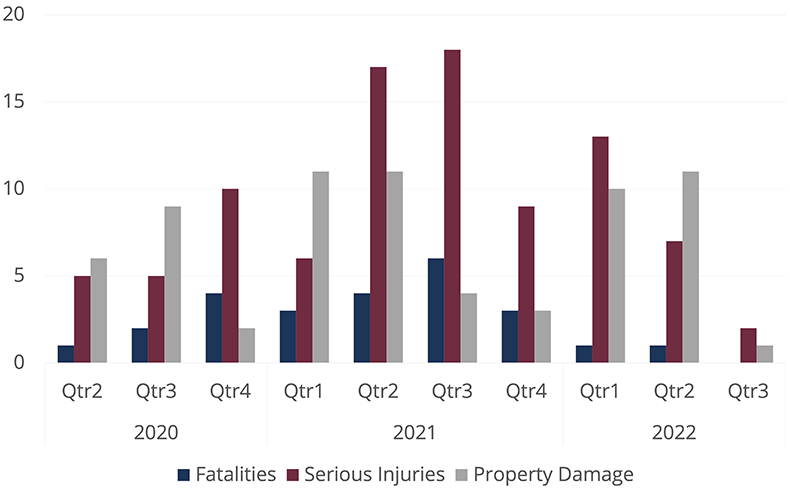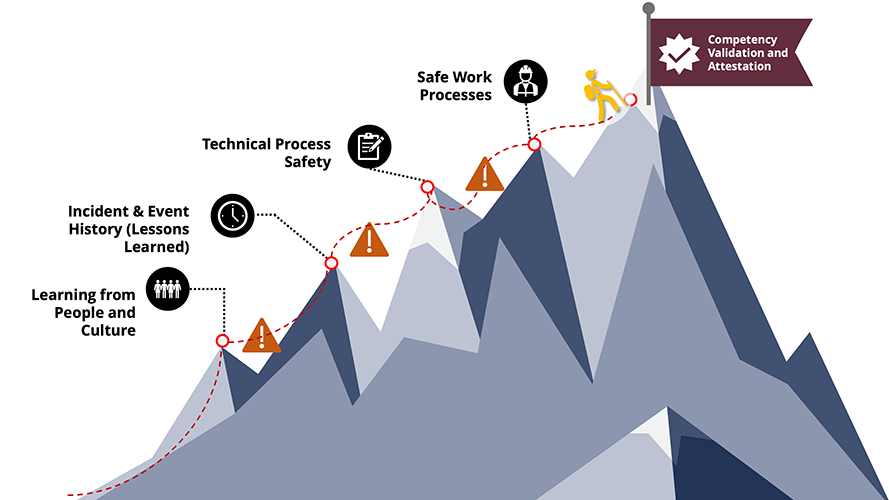
Integrating Process Safety Competency Into Organizational Leadership
Industrial incidents, both nonfatal and fatal, continue to occur at a dangerous and unacceptable level. In 2021, 2.6 million nonfatal injuries or illnesses were reported. In the same year, 5,190 fatal work-related injuries occurred across all sectors.
Annual Fatal Incidents Have Trended Upward Since 2011

Source: U.S. Bureau of Labor Statistics
Furthermore, the Chemical Safety Board (CSB) requires industries to report higher-consequence incidents for publication. The data release is the latest initiative to improve transparency and provide information about chemical incidents. CSB Interim Executive Steve Owens said, “The people of this country have a right to know about chemical incidents that occur in their communities. The CSB is committed to making this important information available to the public.”
Incidents Reported to CSB Following New
“Accidental Release Reporting Rule”

Source: Chemical Safety Board (CSB) “Accidental Release Reporting Rule”
The rule requires prompt reporting to the CSB by owners or operators of facilities that experience an accidental release of a regulated substance or extremely hazardous substance that results in a death, serious injury, or substantial property damage. Since reporting began in March 2020, 162 incidents resulted in 25 fatalities, 92 serious injuries, and 68 instances of substantial property damage.
Coupled with the skills gap in the industrial workforce as experienced safety professionals retire, a systemic integration of process safety competencies is more important than ever before. A proper process safety culture improves human reliability and overall results.
Process Safety Management (PSM) & Beyond
OSHA standards for process safety management (PSM) focus on managing chemical hazards and integrating technologies, procedures, and management practices to avoid risk and protect employees. However, true process safety competency that improves operations and reliability requires efforts beyond compliance. Process safety competency includes managing company culture, human factors, knowledge gaps, strategies to overcome barriers, and continuous measurement, monitoring, and assessment.
Introducing the Process Safety Competency Matrix
The process safety competency matrix ensures comprehensive integration and can be customized to any organization. The matrix includes involving leadership, identifying the organizational structure, transferring, and assessing skills and knowledge/experience, demonstrating proficiency, and overcoming obstacles. The competency matrix is presented in a phased-model approach, with each step up through the model building on the preceding phase. To be sustainably integrated into any organization, the matrix should be accompanied by a barrier analysis. If not properly addressed, barriers can derail the adoption of the process safety competency matrix.
Phases of the Process Safety Competency Matrix

Step 1 (Base Camp): Identify critical roles to deliver high process safety results
First, the critical roles for implementing the model must be identified. Who are the critical process safety leaders? Examples are plant managers, project managers, process safety managers, operations leadership, and others.
Step 2 (Camp 1): Learning from People and Culture: Formalize methods to drive time in field learning from workers
Step 3 (Camp 2): Incident & Event History (Lessons Learned): Formalize knowledge transfer through incident learnings
Step 4 (Camp 3): Technical Process Safety: Demonstrate mitigation systems and risk-reduction methods
Step 5 (Camp 4): Safe Work Processes: Safe Work Practices: Identify key procedures such as line break and return to service

Overcoming Common Barriers to Success
A critical step in integrating the process safety competency is identifying and overcoming the barriers. Barriers can include:
- Time/commitment requirements – standardizing and integrating learning opportunities provide the built-in opportunities to transfer knowledge
- Ever-changing roles – continuous monitoring and assessment allows the model to be dynamic and adapt as required
- Knowledge gaps – industry resources and incident learnings can assist in transferring knowledge throughout the organization
- Knowing how to start – identify key process safety leader(s) in organization who can drive the process. Ensure management is part of the process.
- Begin with building a competency matrix and gaps.
Monitoring, Management, and Assessment For Sustainable Integration
Due to the ever-changing organizational structure and leadership roles, consistent monitoring and management of the model is required for sustainable effectiveness. Identifying measures for success is key to continuous improvement and monitoring. Measures may include incident outcomes as well as increased field presence, increased awareness with key leaders, and increased engagement in process safety work processes.
Assessment can also ensure successful integration and transfer of knowledge. Competency assessment can be accomplished through a variety of techniques including written exams, observations and testing, job shadowing, verbal questioning, and simulations.
References
CCSP, 2015. Defining Process Safety Competency Requirements
CCPS, 2023. CCPS Monograph: Human Factors Primer for Front Line Leaders. Retrieved from aiche.org.

Share This Article!

